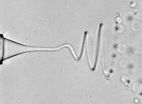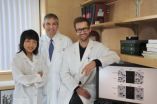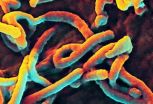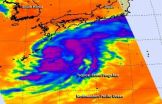(Press-News.org) VIDEO:
This video show jets emerging from the same glass needle in chaotic whipping (left) and a steady state helical whipping. By controlling the viscosity and speed of the liquid surrounding...
Click here for more information.
Industrial wet spinning processes produce fibers from polymers and other materials by using tiny needles to eject continuous jets of liquid precursors. The electrically charged liquids ejected from the needles normally exhibit a chaotic "whipping" structure as they enter a secondary liquid that surrounds the microscopic jets.
But the liquid jets sometimes form a helical wave. And that was intriguing to Alberto Fernandez-Nieves, an associate professor in the School of Physics at the Georgia Institute of Technology.
By controlling the viscosity and speed of the secondary liquid surrounding the jets, a research team led by Fernandez-Nieves has now figured out how to convert the standard chaotic waveform to the stable helical form. Based on theoretical modeling and experiments using a microfluidic device, the findings could help improve industrial processes that are used for fiber formation and electro-spray.
The research, conducted in collaboration with the University of Seville in Spain, was supported by the National Science Foundation (NSF). It was reported Sept. 8, 2014, in the early online edition of the journal Proceedings of the National Academy of Sciences (PNAS).
"We are developing an understanding of the basic coupling between hydrodynamic and electric fields in these systems," said Fernandez-Nieves. "The issue we examined is fundamental physics, but it could potentially lead to something more interesting in fiber generation through electro-spinning."
In conventional industrial processes, tiny metal needles apply an electric field as they eject the polymer-containing solution. In the laboratory, the researchers used a glass-based microfluidic device to create the jets so they could more closely examine what was happening. Using a conductive liquid, ethylene glycol, allowed them to apply an electrical field to produce electrified jets.
"When you charge these polymer solutions, the jets themselves move out of axis, which creates a chaotic phenomenon known as whipping," Fernandez-Nieves explained. "This off-axis movement causes the jet to abruptly move in all directions, and in the industrial world, all that motion seems to be beneficial from the standpoint of making thinner fibers."
The researchers experimented with many variables as their liquid jets emerged into a co-flowing secondary liquid inside the microfluidic device. Those variables included the applied electrical field, the flow rate of the ejected liquid and the secondary liquid, the viscosities of the liquids, the needle diameters and the physical geometry of microfluidic device.
While producing a whipped jet in a viscous dielectric material – polydimethylsiloxane oil – the researchers were surprised to see the chaotic motion switch over to a steady-state helical structure.
"We were able to stabilize the structure associated with the whipping behavior and found that the stable structure is a helix with a conical shape," said Fernandez-Nieves. "You can picture it as a conical envelope, and inside the envelope you have a helix. Once the viscosity of the outer liquid is sufficient, you stabilize the structure and get this beautiful helix."
Georgia Tech postdoctoral fellow Josefa Guerrero used a high-speed, microscope-based video camera operating at 50,000 frames per second to study the waveforms emerging from the experimental jets, which were less than five microns in diameter. The video allowed precise examination of the waveforms produced when the liquid flowed out of the glass needle and into the second liquid flowing around it.
Working with collaborators Javier Rivero-Rodriguez and Miguel Perez-Saborid at the University of Seville, the Georgia Tech team – Fernandez-Nieves, Guerrero and former postdoctoral fellow Venkata R. Gundabala – used hydrodynamics theory to help understand what they were seeing experimentally.
"By developing the model, we were able to balance the importance of the different forces in the experiment," explained Fernandez-Nieves. "The helix was part of the solutions in the model and it reproduced some aspects of the experimentally observed helices."
Once the jets were stabilized by the viscous secondary liquid, the properties of the helix were controlled by the electrical charge. In the experiment, the researchers applied approximately 1,000 volts to generate the jets.
"We learned that the outer fluid plays a major role in stabilizing the structure of the jets," Fernandez-Nieves added. "Once the structure is stable, the details of the properties of the helical structure depend on the charge."
Ultimately, the stable jets break up into spherical droplets. The researchers have not yet formed fibers with their experimental setup.
In future work, Fernandez-Nieves hopes to study other waveforms that may be produced by the system, and evaluate how controlling the liquid jets could improve industrial techniques used in fiber production and electro-spray processes that generate clouds of droplets.
"We are interested in trying to map out those different behaviors," he said. "For us as physicists, this is interesting because it allows us to explore, address and measure things that nobody could look at before in the way we can today. We are anxious to understand the applied impact."
INFORMATION:
Citation
Josefa Guerrero, et al., "Whipping of electrified jets," Proceedings of the National Academy of Sciences, 2014.
This research was funded by the National Science Foundation (NSF) under award CBET-0967293. Any opinions expressed are those of the authors and do not necessarily reflect the officials views of the National Science Foundation.
Co-flowing liquids can stabilize chaotic 'whipping' in microfluidic jets
2014-09-08
ELSE PRESS RELEASES FROM THIS DATE:
Brain injuries no match for sPIF treatment
2014-09-08
New Haven, Conn. — Researchers at Yale School of Medicine and their colleagues have uncovered a new pathway to help treat perinatal brain injuries. This research could also lead to treatments for traumatic brain injuries and neurodegenerative disorders such as Alzheimer’s and Parkinson’s.
The findings are published in the Sept. 8 issue of Proceedings of the National Academy of Sciences.
The microRNA let-7 is known to cause the death of neurons in the central nervous system. The research team found that a synthetic molecule derived from the embryo called PreImplantation ...
Textbook theory behind volcanoes may be wrong
2014-09-08
In the typical textbook picture, volcanoes, such as those that are forming the Hawaiian islands, erupt when magma gushes out as narrow jets from deep inside Earth. But that picture is wrong, according to a new study from researchers at Caltech and the University of Miami in Florida.
New seismology data are now confirming that such narrow jets don't actually exist, says Don Anderson, the Eleanor and John R. McMillian Professor of Geophysics, Emeritus, at Caltech. In fact, he adds, basic physics doesn't support the presence of these jets, called mantle plumes, and the ...
UCLA biologists delay the aging process by 'remote control'
2014-09-08
UCLA biologists have identified a gene that can slow the aging process throughout the entire body when activated remotely in key organ systems.
Working with fruit flies, the life scientists activated a gene called AMPK that is a key energy sensor in cells; it gets activated when cellular energy levels are low.
Increasing the amount of AMPK in fruit flies' intestines increased their lifespans by about 30 percent — to roughly eight weeks from the typical six — and the flies stayed healthier longer as well.
The research, published Sept. 4 in the open-source journal Cell ...
Rapid and durable protection against ebola virus with new vaccine regimens
2014-09-08
One shot of an experimental vaccine made from two Ebola virus gene segments incorporated into a chimpanzee cold virus vector (called chimp adenovirus type 3 or ChAd3) protected all four macaque monkeys exposed to high levels of Ebola virus 5 weeks after inoculation, report National Institutes of Health (NIH) scientists and their collaborators. The ability of the ChAd3 Ebola virus vaccine to elicit rapid protection in monkeys is notable as the world health community battles an ongoing Ebola virus disease outbreak in West Africa. While the protective effects of the single ...
Teens living with 2 college-educated parents less likely to use alcohol and marijuana
2014-09-08
ARLINGTON, Texas -- A high school senior who lives with two college-educated parents is significantly less likely to drink alcohol or smoke marijuana than a teenager who lives with one parent, a new University of Texas at Arlington study has found.
For example, teens living with their mother only are 54 percent more likely to use alcohol, and 58 percent more likely to smoke if they live only with their father.
Eusebius Small, an assistant professor in the UT Arlington School of Social Work, analyzed data on 14,268 teenagers to determine the impact of family structure ...
Ohio University paleontologists discover new species of titanosaurian dinosaur in Tanzania
2014-09-08
ATHENS, Ohio (Sept. 8, 2014)—Ohio University paleontologists have identified a new species of titanosaurian, a member of the large-bodied sauropods that thrived during the final period of the dinosaur age, in Tanzania. Although many fossils of titanosaurians have been discovered around the globe, especially in South America, few have been recovered from the continent of Africa.
The new species, named Rukwatitan bisepultus, was first spotted by scientists embedded in a cliff wall in the Rukwa Rift Basin of southwestern Tanzania. Using the help of professional excavators ...
In one of nature's innovations, a single cell smashes and rebuilds its own genome
2014-09-08
Life can be so intricate and novel that even a single cell can pack a few surprises, according to a study led by Princeton University researchers.
The pond-dwelling, single-celled organism Oxytricha trifallax has the remarkable ability to break its own DNA into nearly a quarter-million pieces and rapidly reassemble those pieces when it's time to mate, the researchers report in the journal Cell. The organism internally stores its genome as thousands of scrambled, encrypted gene pieces. Upon mating with another of its kind, the organism rummages through these jumbled genes ...
Gobbling up poison: A method for killing colon cancer
2014-09-08
(PHILADELPHIA) – These days, cancer researchers aim to design targeted and specific therapy – those that kill cancer but spare the surrounding tissue. Immunotoxins, which use cancer-targeted antibodies linked to deadly toxins such as ricin, are one such therapy. However, few have succeeded to date in part because cancer cells share many molecules with normal cells, and because it can be challenging to unlock the deadly chemical only after the antibody has homed to the diseased tissue.
Now researchers at Thomas Jefferson University have discovered the unique biological ...
Soft robot squirms over fire, ice, and withstands crushing force
2014-09-08
ITHACA, N.Y. – Engineers have created a shape-changing "soft" robot that can tread over a variety of adverse environmental conditions including snow, puddles of water, flames, and the crushing force of being run over by an automobile.
Videos: https://cornell.box.com/softrobot
The engineers from Cornell and Harvard Universities will detail the robot in an upcoming edition of the journal Soft Robotics. An early online version of the study can be found at: http://online.liebertpub.com/doi/full/10.1089/soro.2014.0008
The pneumatically powered, fully untethered robot was ...
NASA sees large Tropical Storm Fengshen skirting eastern Japan's coastline
2014-09-08
Tropical Storm Fengshen is a large storm and infrared imagery from NASA's Aqua satellite shows that it's about as long as the big island of Japan.
NASA's Aqua satellite passed over Tropical Storm Fengshen on September 7 and the Atmospheric Infrared Sounder instrument known as AIRS gathered temperature data about the storm's cloud tops and surrounding sea surface temperatures. The infrared data showed strong thunderstorms surrounded the center of circulation and also appeared in large bands south and northeast of the storm's center. Another large and fragmented band on ...








